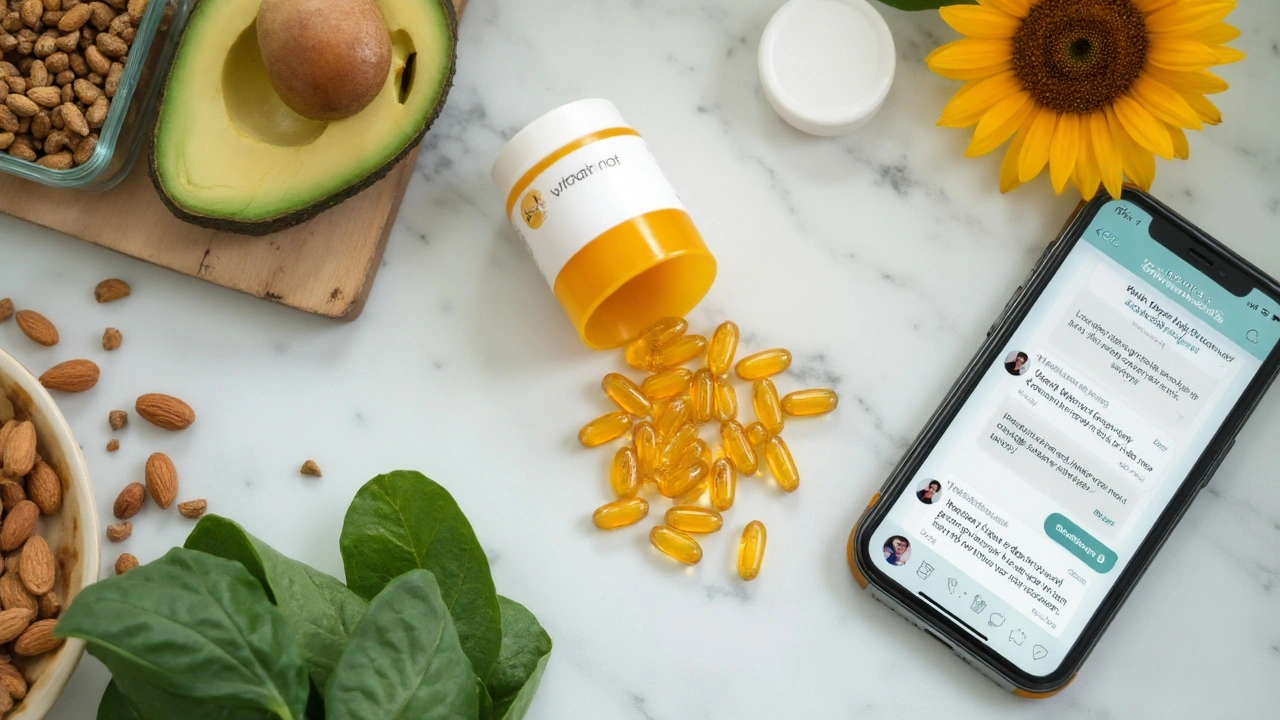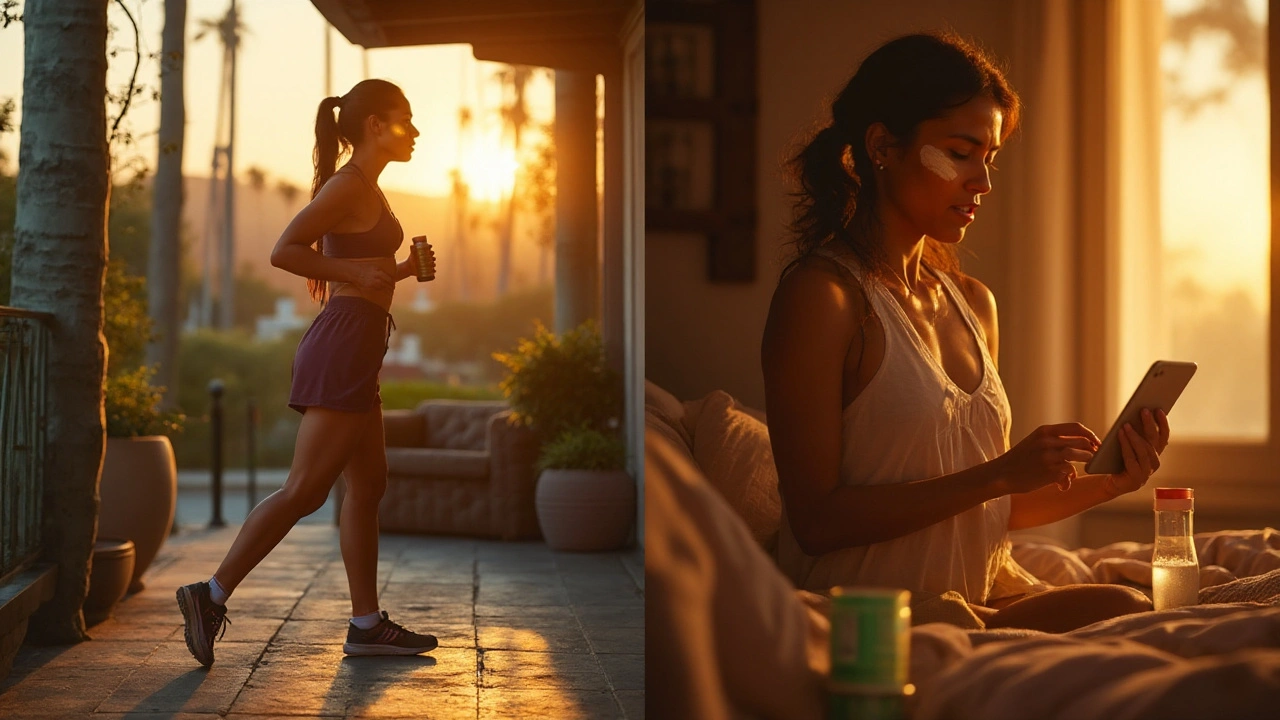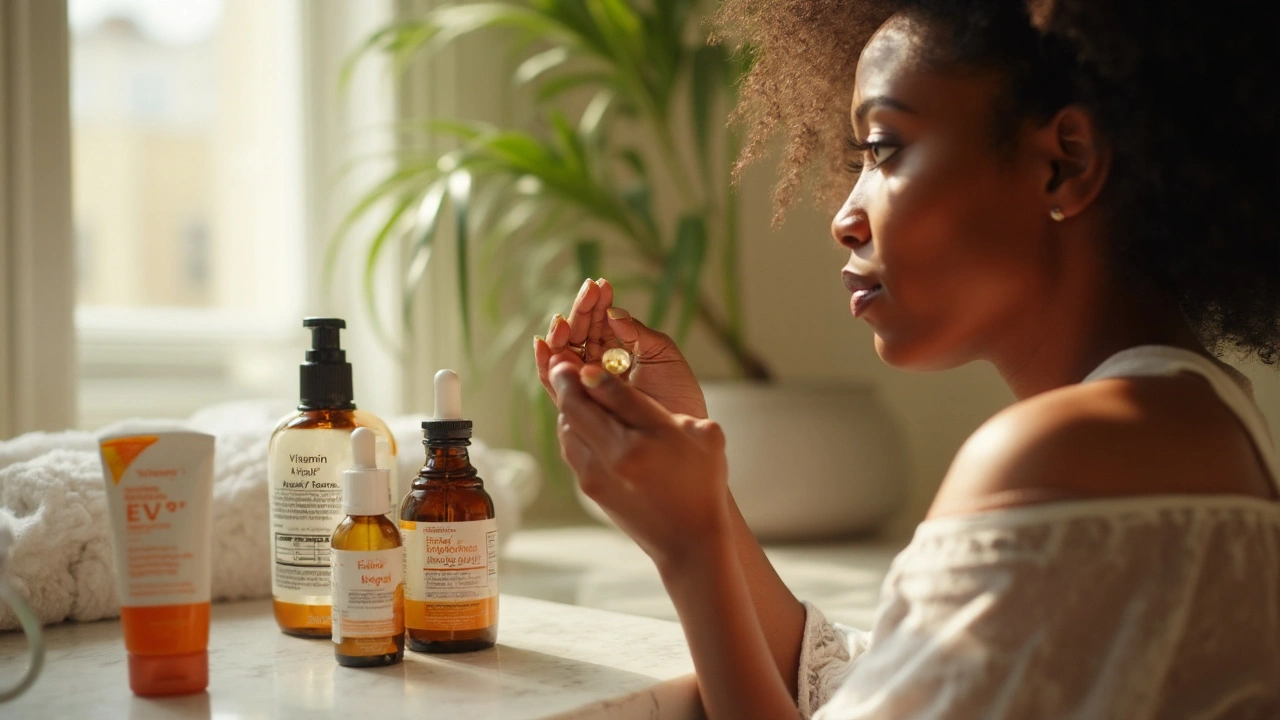You want a glow that lasts and a body that keeps up. Vitamin E gets hyped as a beauty-and-health multitasker, but the truth sits between “miracle” and “meh.” Used right, it can support skin barrier strength, help with dryness, and back your cells against oxidative stress. Used wrong, it can work against you-especially at high doses or with certain meds. Here’s the clean, practical way to make it work for you.
- Vitamin E supports cell membranes, skin barrier function, and immune health; it’s not a cure-all for wrinkles or acne.
- Most adults need 15 mg/day from food or supplements; mega-doses aren’t better and can raise bleeding risk.
- Choose RRR-alpha-tocopherol (natural) or mixed tocopherols; take with fat for better absorption.
- For beauty, combine vitamin C + E + sunscreen topically; oral E helps when your diet falls short.
- Check meds (especially blood thinners) and keep daily totals below the upper limit unless your clinician says otherwise.
Why Vitamin E Helps (and Where It Doesn’t): Real Benefits for Health and Beauty
Vitamin E is a family of fat-soluble antioxidants-mostly tocopherols and tocotrienols-with alpha-tocopherol being the main form your body uses. It protects cell membranes from oxidative damage, which shows up in daily life as better moisture retention in skin, more resilient nails, and support for immune cells under stress.
Here’s the science in plain English. The National Academies (Institute of Medicine) set the adult Recommended Dietary Allowance (RDA) at 15 mg/day of alpha-tocopherol. The NIH Office of Dietary Supplements highlights its role in protecting lipids from oxidation-think of it as shielding the “oil” parts of your cells. In skin care, dermatology research notes that vitamin C and E used together can boost photoprotection and reduce markers of UV damage when paired with sunscreen. That pairing is why so many brightening serums include both.
What about skin smoothing, acne, or scars? Claims outpace evidence. Some small trials have shown oral vitamin E can help with atopic dermatitis symptoms, likely through anti-inflammatory effects and barrier support, but results are mixed and not universal. For acne or scar prevention, data is limited-some people even break out or get contact dermatitis from topical E. Translation: use it strategically, not as a blanket fix.
On overall health, vitamin E is essential, but more isn’t better. High-dose long-term supplementation hasn’t consistently prevented heart disease, and one large trial in men (SELECT, published in JAMA) found an increased risk of prostate cancer with 400 IU/day of synthetic alpha-tocopherol. A BMJ meta-analysis linked high-dose vitamin E to a small increase in hemorrhagic stroke. The takeaway: smart dosing and context matter.
Deficiency is uncommon if you absorb fat normally, but it happens with certain conditions (fat malabsorption, rare genetic disorders). Signs include neuropathy, muscle weakness, and visual changes. If you suspect deficiency, that’s a medical conversation, not a supplement aisle decision.
Bottom line: vitamin E supplements can support skin barrier resilience and overall antioxidant needs when your diet falls short, but they’re not magic. Use diet first, supplement low-to-moderate, and pair topical E with C and sunscreen for beauty wins.
How to Choose and Use Vitamin E Safely (Step-by-Step)
Define your goal. Be specific. “Hydrate dry skin,” “support nails,” “fill dietary gap,” or “antioxidant back-up during intense training.” If your goal is wrinkle erasing or acne clearing, you’ll need a broader strategy-sunscreen, retinoids, gentle exfoliation, and possibly a dermatologist-not vitamin E alone.
Audit your diet. Track 3 days. Add up vitamin E from foods like sunflower seeds, almonds, wheat germ oil, avocado, spinach, and olive oil. If you’re hitting 15 mg/day most days, you probably don’t need a supplement, or you can keep it very low.
Pick the form. Look for RRR-alpha-tocopherol (natural) or a “mixed tocopherols” blend. Avoid mega-dose softgels unless prescribed. If you’re sensitive to soy, check the carrier oil (many use soybean, sunflower, or safflower oil).
Choose a dose. As a general, conservative range for healthy adults looking for beauty/maintenance: 15-67 mg/day (about 22-100 IU). This covers the RDA without drifting into high-dose territory. Many store-bought softgels are 134-268 mg (200-400 IU)-that’s more than most people need daily.
Timing and how to take. Take it with a meal that contains fat-like eggs with avocado, yogurt with nuts, or a salad dressed with olive oil. Fat boosts absorption significantly.
Pair with topical strategy. For photoprotection and glow, use a morning vitamin C + E + ferulic serum under broad-spectrum sunscreen. Oral E won’t replace sunscreen. Evening: moisturize; if you tolerate it, a cream with tocopherol can help dryness.
Safety check. If you take warfarin, direct oral anticoagulants, antiplatelets, or high-dose omega-3, talk to your clinician first-vitamin E can increase bleeding risk at higher intakes. If you’re scheduled for surgery, supplements are usually paused 1-2 weeks before. If you’re pregnant or breastfeeding, stick close to the RDA unless your provider advises otherwise.
Reassess in 8-12 weeks. Look for changes you can feel and see: less flaking, better moisture retention, fewer hangnails, nails splitting less. If nothing changes and your diet is decent, you may not need the supplement.

Practical Routines, Food Pairings, and Real-World Examples
Here are simple, realistic ways to fold vitamin E into your day without turning your life into a chemistry set.
Morning skin routine: Cleanser → vitamin C + E + ferulic serum → moisturizer → sunscreen. If you supplement, take your softgel with breakfast that includes fat (e.g., Greek yogurt with almonds, or eggs and sautéed spinach).
Evening routine: Gentle cleanse → retinoid (if you use one) → moisturizer. If your skin is reactive, skip topical vitamin E or use a product with a lower tocopherol concentration to test tolerance.
Diet-first day: Oatmeal topped with 1 oz almonds (≈7 mg), lunch salad with 1 Tbsp olive oil and half an avocado (≈2-3 mg), spinach side at dinner (≈2 mg). You’re close to the 15 mg target without a pill.
Beauty-focused day with a small supplement: Target 10-12 mg from food and add a 15-30 mg supplement (about 22-45 IU) with dinner.
Travel hack: Single-serve nut packs and sunflower seeds are easy vitamin E wins. Add to yogurt or salads when eating out.
Hair and nails? There’s no strong proof that oral vitamin E alone thickens hair, but addressing dryness and supporting scalp barrier health can make hair behave better. Nails often show quicker wins-fewer splits and hangnails-when you combine adequate E with biotin from food (eggs, salmon) and consistent hand moisturizing.
Topical caveat: Some people get contact dermatitis from pure tocopherol oils. Patch test on your inner arm for 24-48 hours before using on your face. If you’re acne-prone, look for lighter emulsions rather than heavy vitamin E oils.
Cheat Sheets: Dosage Rules, Food Sources, and Smart Buying (with Table)
Keep these quick rules and references nearby.
- Rule of thumb: Food first. Use low-to-moderate supplements if your diet is light on nuts, seeds, and greens.
- Start low: 15-30 mg/day if you need a bump; reassess in 8-12 weeks.
- Do not exceed: Stay well under the adult upper limit of 1000 mg/day (alpha-tocopherol) unless medically supervised.
- Pair smart: For sun defense, topical vitamin C + E + sunscreen beats E alone.
- Bleeding risk check: If you bruise easily, have nosebleeds, or use blood thinners, involve your clinician.
| Item | Adults | Notes |
|---|---|---|
| RDA (alpha-tocopherol) | 15 mg/day | 19 mg/day if lactating (National Academies) |
| Upper Limit (UL) | 1000 mg/day | Applies to supplemental alpha-tocopherol (NIH ODS) |
| Common softgel doses | 15-67 mg (22-100 IU); 134 mg (200 IU); 268 mg (400 IU) | Higher doses not routinely needed |
| IU ↔ mg (natural RRR) | 1 IU = 0.67 mg | 1 mg = 1.49 IU |
| IU ↔ mg (synthetic all-rac) | 1 IU = 0.45 mg | 1 mg = 2.22 IU |
| Sunflower seeds | 1 oz ≈ 7.4 mg | Easy snack add-on |
| Almonds | 1 oz ≈ 7.3 mg | Toss into oatmeal or salads |
| Wheat germ oil | 1 Tbsp ≈ 20 mg | Potent source |
| Avocado | ½ medium ≈ 2 mg | Great with eggs or toast |
| Spinach (cooked) | ½ cup ≈ 1.9 mg | Side with dinner |
- Buying checklist:
- Form: “RRR-alpha-tocopherol” or “mixed tocopherols.”
- Third-party tested: USP, NSF, or Informed Choice.
- Dose: Aim 15-67 mg unless directed otherwise.
- Allergens: Check carrier oils (soy, sunflower, safflower).
- Label clarity: Lists mg of alpha-tocopherol, not just IU.
- Simple decision flow:
- Do you hit 15 mg/day from food most days? If yes → consider skipping or use a low dose occasionally.
- If no → add nuts/seeds/greens first for 2 weeks → reassess.
- Still low or you want a modest boost for skin/nails → choose 15-30 mg/day with a meal.
- On blood thinners, have a bleeding disorder, or surgery soon → talk to your clinician before any dose.

FAQ and What to Do Next
Does vitamin E actually make skin look better?
Indirectly, yes. By supporting barrier function and reducing lipid peroxidation, many people notice less dryness and better texture. For sun damage, topical vitamin C + E with sunscreen helps more than E alone. For wrinkles and acne, you’ll need the usual heroes: sunscreen and retinoids.
Is natural vitamin E better than synthetic?
Natural (RRR-alpha-tocopherol) is more bioactive per IU than synthetic (all-rac), so labels can be confusing. If you compare by milligrams of alpha-tocopherol, you’re looking at the same biologically relevant unit. I prefer formulas that list mg clearly.
Can I take vitamin E with fish oil?
Be cautious at higher doses. Both can affect bleeding risk. If you’re on antiplatelets or anticoagulants, check with your clinician. At typical food-level intakes, it’s usually fine.
Is vitamin E safe in pregnancy?
Stick close to the RDA (15 mg/day) unless your prenatal team recommends otherwise. High-dose vitamin E hasn’t shown consistent benefits in pregnancy and can add risk.
What about men and prostate cancer?
A large trial (SELECT) found increased prostate cancer risk with 400 IU/day synthetic alpha-tocopherol in healthy men. If you supplement, keep doses modest and food-focused unless your clinician advises differently.
Can I use vitamin E oil on scars?
Evidence is mixed. Some people get contact dermatitis from pure E oil. Silicone gels, sunscreen, and time often do more. If you try it, patch test first and monitor for irritation.
How long until I notice improvements?
For dryness and nail brittleness, give it 8-12 weeks. For photoprotection, the topical combo works right away-assuming you’re wearing sunscreen.
Are tocotrienols better?
They’re part of the vitamin E family with interesting lab data, but everyday benefits for skin and general health aren’t as well established as alpha-tocopherol. Not essential for most people.
Should I take vitamin E before workouts?
You don’t need to time it around workouts. Some high-dose antioxidant regimens may blunt training adaptations; keep doses modest and prioritize food sources if you’re an athlete.
Next steps for your scenario
- The minimalist: Eat a handful of almonds or sunflower seeds daily, cook with olive oil, and skip the pill unless your diet dips.
- Beauty-focused, sensitive skin: Use a gentle vitamin C + E serum under sunscreen. If oils clog you, choose a lightweight emulsion. Oral E at 15-30 mg/day with a fat-containing meal is plenty.
- Plant-based eater: You’re set if you love nuts, seeds, and greens. Track a few days; add wheat germ oil to smoothies if needed.
- Men 50+: If you supplement, avoid high-dose (e.g., 400 IU/day) without medical guidance. Keep it food-first or low-dose.
- On blood thinners or pre-surgery: Discuss with your clinician before starting. You may need to pause supplements pre-op.
- Athlete in heavy training: Focus on diet sources and modest supplemental doses if needed; don’t megadose antioxidants around workouts.
Credible sources I trust when checking details: NIH Office of Dietary Supplements (for RDA, UL, forms), National Academies of Sciences/Institute of Medicine (dietary reference intakes), Journal of the American Academy of Dermatology and Dermatologic Surgery (topical C + E photoprotection), JAMA (SELECT trial on prostate risk), and BMJ (meta-analysis on hemorrhagic stroke risk at high doses).
If you want the simplest action plan: hit 15 mg/day with food, add a low-dose supplement only if your diet misses the mark, take it with fat, and use a vitamin C + E serum plus daily sunscreen. That’s the practical sweet spot for real-world glow and health support without the drama.







Comments
Richard Phelan
If you think a megadose of vitamin E will turn you into a glowing marble statue, stop the fantasy. The body only needs about fifteen milligrams a day, and anything wildly beyond that just crowds the bloodstream. Excess tocopherol acts like a sneaky thief, stealing the spotlight from other antioxidants and even nudging clotting factors toward the edge. That’s why the SELECT trial flagged a rise in prostate cancer when men gulped four hundred IU of synthetic E every day. Likewise, the BMJ meta‑analysis whispered a modest uptick in hemorrhagic strokes for high‑dose devotees. Bottom line: more is not better, and “more” in this case means you’re courting danger. Stick to the natural RRR‑alpha‑tocopherol form, because the synthetic all‑rac version is a half‑life impostor. When you pop a softgel, pair it with a buttery bite-think avocado toast or a handful of almonds-so the fat‑soluble molecule slides into your cells without protest. If your diet already delivers a solid handful of nuts, seeds, or a drizzle of wheat germ oil, you can probably skip the pill entirely. For skin that feels like sandpaper, a low‑dose supplement of fifteen to thirty milligrams can patch the moisture gap, but expect results after eight to twelve weeks, not overnight. Topical vitamin E oils are a double‑edged sword: they can soothe dry patches, yet they also love to clog pores in acne‑prone folks. The safest cosmetic playbook is vitamin C + E + ferulic acid under a broad‑spectrum sunscreen, because that trio actually neutralizes UV‑induced free radicals. If you’re on warfarin or any blood‑thinner, lock the supplement down to the RDA or pause it before surgery-bleeding risk isn’t a myth. Pregnant or nursing mothers should cling to the dietary reference intake and avoid megadoses unless a physician waves the green light. Remember, food first: a spoonful of sunflower seeds, a drizzle of olive oil, a side of spinach-these are the real MVPs. So, ditch the hype, respect the numbers, and let vitamin E be a quiet backstage helper, not the headline act.
benjamin malizu
Your exposition conflates pharmacokinetic saturation with therapeutic efficacy, which are orthogonal concepts. The cited SELECT trial, while pivotal, employed an all‑rac synthetic formulation, thus limiting its extrapolation to natural RRR‑E. Consequently, a nuanced dose‑response curve remains unresolved.
Maureen Hoffmann
Alright, let’s break this down like a workout plan: first, check your plate. If you’re already scooping up a handful of almonds, a splash of olive oil, and a side of spinach, you’ve probably met the RDA without a pill. Next, set a clear goal-whether it’s smoother elbows or less flaky cheeks-because vitamin E is a support player, not a miracle cure. A modest supplement of 15–30 mg taken with a fat‑rich meal can fill the gap, and you’ll start to see a difference in about two months. Finally, pair it with a solid sunscreen and a vitamin C serum, and you’ve built a defense system that even the sun can’t outwit.
Alexi Welsch
While the enthusiasm is commendable, it must be underscored that the pharmacological premise presented lacks rigorous stratification of confounding variables, particularly dietary baseline intake. Moreover, the recommendation to employ “low‑to‑moderate” dosages without specifying a precise concentration may engender heterogeneity in clinical outcomes. A more circumspect approach would delineate explicit milligram thresholds aligned with established tolerable upper intake levels.
Louie Lewis
The elite circles whisper that the supplement industry hides the true dosage matrix.
Eric Larson
Wow, that’s a bold claim – really, it makes me think about the hidden agendas lurking behind glossy label designs, and honestly, the lack of transparency is astonishing, especially when we consider how many people just grab whatever’s on the shelf, hoping for miracles, without a second thought about bioavailability, carrier oils, or the subtle nuances between natural RRR‑alpha‑tocopherol and synthetic all‑rac forms!!!
Kerri Burden
From a practical standpoint, the key takeaway is to audit your daily menu first. Track nuts, seeds, and oil portions for a few days; if you consistently hit around fifteen milligrams, a supplement is likely redundant. If there’s a shortfall, a modest capsule taken with breakfast-preferably alongside avocado or Greek yogurt-covers the gap efficiently. Remember, consistency beats occasional mega‑doses, and pairing with sunscreen remains non‑negotiable for photoprotection.
Joanne Clark
i think ur right but also dont forget that many ppl cant afford fancy supplements lol
George Kata
Indeed, budget constraints are a real factor-however, even inexpensive sources like sunflower seeds or a drizzle of wheat germ oil can furnish the requisite tocopherols; just remember to keep the serving sizes consistent, and you’ll avoid both deficiency and excess.
Nick Moore
Hey folks, keep it simple and stay positive-your skin will thank you for the steady, sensible approach. 🍃 A little patience, a dash of good food, and the right sunscreen are all you really need.
Jeffery Reynolds
The preceding comment contains multiple grammatical inaccuracies; specifically, the phrase “keep it simple and stay positive-your skin will thank you” should employ a semicolon or period to separate independent clauses, and the emoji usage is informal in scholarly discourse.
Mitali Haldankar
Vitamin E is cool 😎👍
snigdha rani
Oh sure, because popping a pill is totally the same as eating a handful of almonds, right?